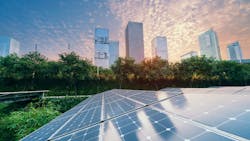DOE Provides US$65 Million to Expand Network of Grid-Interactive Efficient Buildings
The U.S. Department of Energy (DOE) recently announced up to US$65 million through its Connected Communities funding opportunity announcement (FOA) to expand the DOE's network of grid-interactive efficient building communities nationwide.
"As our nation's energy system continues to undergo dramatic transformations, there is a growing need for solutions that integrate and optimize all of our energy resources on the grid to provide Americans with the most reliable and affordable electricity possible," said Secretary of Energy Dan Brouillette. "With the recent announcement, the DOE will broaden its capability to evaluate and demonstrate the growing flexibility of one such solution — smart, grid-interactive, efficient buildings — to best serve the needs of building occupants and the grid, while reducing energy consumption overall."
America's 125 million homes and commercial buildings currently use almost 40% of U.S. energy, 74% of its electricity, and account for a great majority of peak electricity demand. Connected communities can leverage the latest advancements in building science, like state-of-the-art sensors, controls, and analytics, to more flexibly manage and deploy grid-scale energy efficiency and distributed energy resources (DERs).
"The integration of emerging technologies and systems is essential to the success of efforts to maximize the effectiveness of advanced building technologies," said Assistant Secretary for Energy Efficiency and Renewable Energy Daniel R. Simmons. "Our grid-interactive efficient buildings initiative helps the United States further modernize its power grid and thus improve reliability, integrate renewable power sources, improve environmental performance, and make electricity more affordable for America's households and businesses."
Integration is at the heart of the Connected Communities FOA. The Building Technologies Office (BTO) within the DOE's Office of Energy Efficiency and Renewable Energy (EERE) is collaborating with the EERE's Solar Energy Technologies Office and Vehicle Technologies Office, and the DOE's Office of Electricity and Lawrence Berkeley National Laboratory to bring together critical technologies and programs.
The FOA, first described in a notice of intent and later shaped by responses to a request for information, could increase by five-fold the number of EERE-supported testbeds like Reynolds Landing in Hoover, Alabama. As a recent report by Oak Ridge National Laboratory shows, Reynolds Landing uses 44% less energy than comparable all-electric communities and 34% less power demand during winter peak hours, leading to lower utility bills for families while in higher-functioning houses.
To learn more about this FOA and submit a concept paper, visit here.
